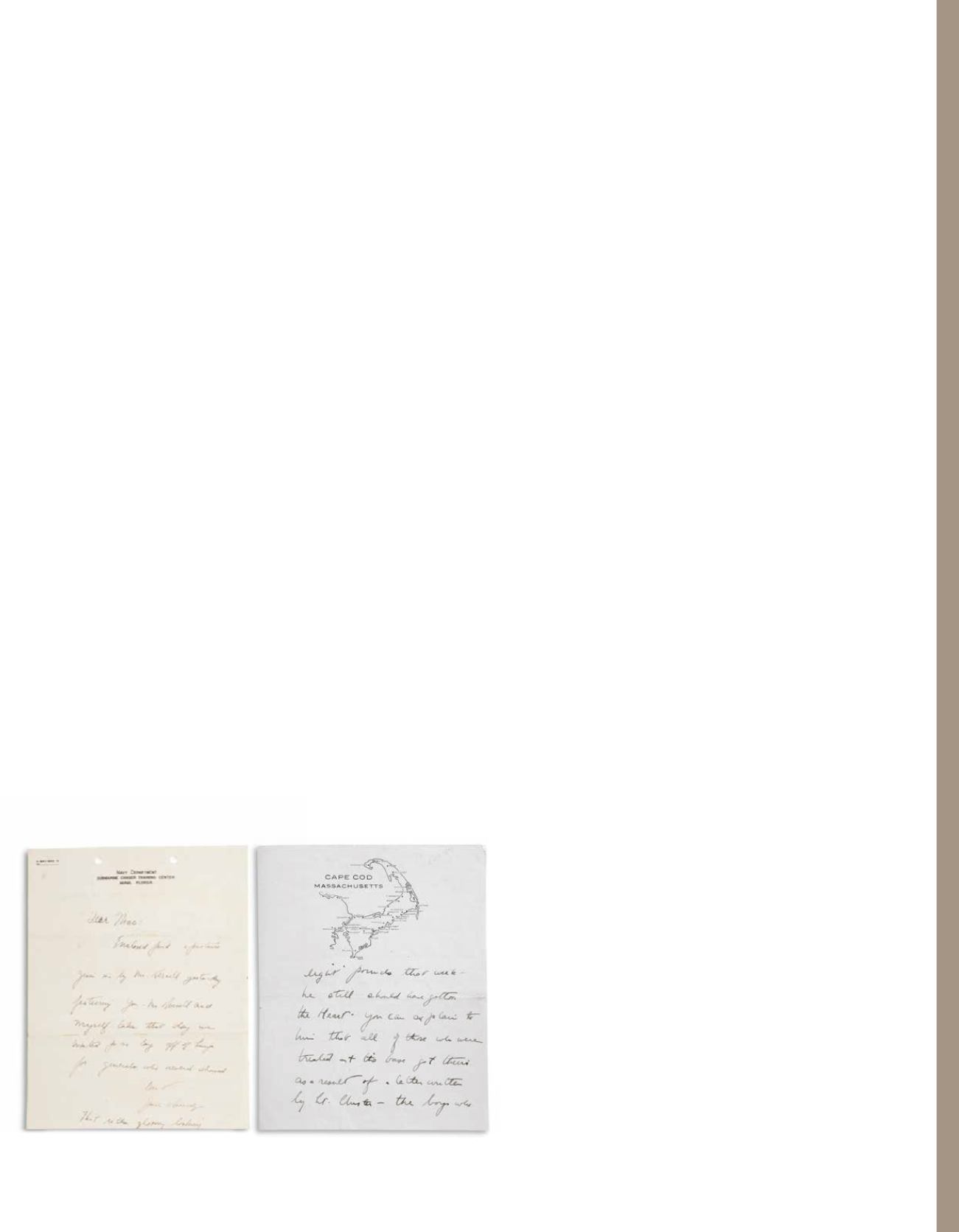

141
britannica - americana
106
KENNEDY JOHN FITZGERALD
(1917-1963).
L.A.S. « Jack Kennedy »,
Miami
[18 mai 1944], à John E.
MAGUIRE, opérateur de radio de 2
e
classe, au Motor
Torpedo Boat Squadrons Training Center, à Melville, Rhode
Island ; 1 page et quart in-4, en-tête
Navy Department
Submarine Chaser Training Center
(trous de classeur en
tête), enveloppe autographe avec nom et adresse de J. F.
Kennedy sur le « P.T. Shakedown » ; en anglais.
1 500 / 2 000 €
[John E. MAGUIRE, dit « Mac », était membre de l’équipage du célèbre
patrouilleur-torpilleur PT-109 que Kennedy avait commandé dans le
Pacifique, et qui fut coulé par un destroyer japonais.]
Kennedy envoie à Mac une photo que Mr. Kernell lui a donnée la veille,
et mettant en vedette Mac, Kernell et Kennedy lui-même, prise le jour où
ils ont tant attendu, pour quitter Lunga [sur la côte nord de Guadalcanal],
des généraux qui ne se sont jamais manifestés… Le type sombre à
droite, qui manifestement souhaite être de retour aux U.S., c’est Mac…
On joint
une photo de presse de l’équipage du PT-109, avec Kennedy
à droite (
R.W. Sears, Universal Newsreel).
KENNEDY JOHN FITZGERALD
(1917-1963).
Signed autograph letter, signed « Jack Kennedy »,
Miami
[18 mai 1944], to John E. MAGUIRE, Radioman 2
nd
Class on
the PT-109, at the Motor Torpedo Boat Squadrons Training
Center, in Melville, Rhode Island; 1 page and a quarter, in-4
format, letterhead stationery
“Navy Department Submarine
Chaser Training Center”
(perforations to paper), envelope
with autograph inscriptions and J. F. Kennedy’s address on
the « P.T. Shakedown »; in English.
1 500 / 2 000 €
John E. MAGUIRE, called « Mac », was a member of the crew of the
motor torpedo boat commanded by the young Lieutenant Kennedy
in the Pacific that was ultimately sunk by the Japanese during the
Guadalcanal campaign. Both men were PT-109 survivors. The letter
documents the enduring sense of camaraderie between the two
men, and the warm attachment between them which lasted through
Kennedy’s subsequent career in Congress and the Senate.
Kennedy sends Mac a photo that Mr. Kernell gave her the day before:
“Enclosed please find a picture...featuring you, Mr. Kernell and myself
taken that day we waited for so long off Lunga [Guadalcanal] for
generals who never showed.” In a postscript, he adds, “That rather
gloomy looking gent to the right who is obviously wishing he was
back in the States is you.”
Kennedy had joined the Navy in September 1941: he and his crew were
posted to the Solomon Islands in April 1943, during the critical Guadalcanal
campaign, working to interdict Japanese supply columns (“the Tokyo
express”). On the night of August 2, 1943, while on patrol in the Solomon
Islands, the vessel was rammed by the Japanese destroyer, Amagiri,
killing two crewmen. At the time the collision occurred, Maguire and
Kennedy were in the cockpit together. After the wreckage of the vessel
sank, the surviving crew eventually swam to safety. In spite of his badly
injured back, Kennedy swam for four hours towing a wounded crewman
by the strap of a life-jacket held in his teeth. After several days on two
small islands, they were rescued with the aid of coast-watchers and
Solomon islanders. Kennedy was awarded a purple heart and the Navy
and Marine Corps medal for his heroic actions, but spent months in
the hospital and was never able to return to active duty.
Sold with
a press photograph showing the crew of the PT-109, with
Kennedy to the right
(R.W. Sears, Universal Newsreel).
107
KENNEDY JOHN FITZGERALD
(1917-1963).
L.A.S. « Jack » (incomplète du début), [6 décembre 1944,
à John E. MAGUIRE] ; 3 pages in-8, vignette à la carte
de
Cape Cod Massachusetts
; en anglais.
1 000 / 1 500 €
À propos d’une décoration due à leur compagnon d’armes le torpilleur
(TM2) Ray L. Starkey.
[John E. MAGUIRE, dit « Mac », était membre de l’équipage du célèbre
patrouilleur-torpilleur PT-109 que Kennedy avait commandé dans le
Pacifique, et qui fut coulé par un destroyer japonais.]
Il aurait dû recevoir le Cœur [le
Purple Heart,
médaille accordée aux
soldats blessés ou tués]. Il faut lui expliquer que tous ceux qui ont
été soignés à la base ont eu la leur grâce à une lettre écrite par le
lieutenant Cluster – les garçons soignés à l’hôpital à Tulagi ont eu les
leurs en s’y rendant et en les récupérant – ; c’est ce que Starkey aurait
dû faire. Quoi qu’il en soit, qu’il montre d’abord son dossier médical
au toubib là-bas, pour voir s’il y a une note quelconque suffisante pour
qu’il la récupère dans ce pays. Autrement, s’il la veut, il faudra qu’une
lettre soit écrite à cet hôpital à Tulagi. Qu’il voie M. Thom [l’enseigne]
à ce sujet, et on arrangera quelque chose de satisfaisant pour lui…
KENNEDY JOHN FITZGERALD
(1917-1963).
Signed autograph letter, signed « Jack » (wanting the
beginning), [6 December 1944, to John E. MAGUIRE];
3 pages in-8 format, stationery with vignette, map of
Cape
Cod Massachusetts;
in English.
1 000 / 1 500 €
Letter concerning a purple heart military decoration deserved by their
mutual brother in arms Ray L. Starkey.
Kennedy writes: “[…] he still should gotten the Heart. You can explain to
him that all of those who were treated at the base got theirs as a result of
a letter written by Lt. Cluster… Otherwise, if he wants it, a letter will have
to be written to the hospital at Tulagi. Have him see M. Thom about it
and something can be worked out for him which is satisfactory. Jack”.
106
107
















